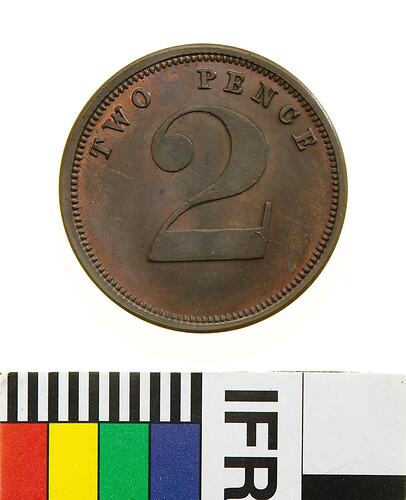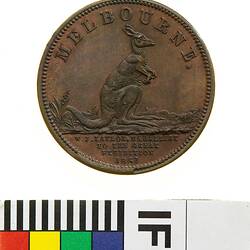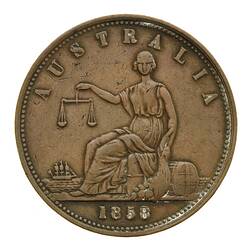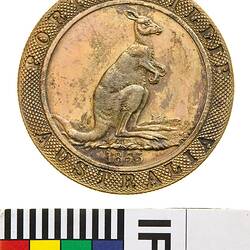Summary
Copper Two Pence Pattern token, minted by W.J. Taylor of London. It was supposedly issued from the Kangaroo Office, in Melbourne, Victoria. Reginald Scaife of the Kangaroo Office, Melbourne informed Taylor that he might be able to get orders for 2d, 3d and 4d tokens from Sydney in 1854. This twopence design appears to be made by Taylor in response to this suggestion.
W. J. Taylor and his business partners established the Kangaroo Office to take advantage of the explosive economic growth in Australia following the discovery of gold in 1851. They hoped to buy gold at greatly reduced prices from the gold fields and then release it at full value in the form of quarter-ounce, half-ounce, one ounce and two ounce gold coins. However due to the time required to travel between London and Melbourne, once the Kangaroo Office was ready for business in 1854, an increase in the number of British sovereigns, had seen the price of gold rise, and the potential profits for the Kangaroo Office sharply decline. Not deterred, in late 1954 Taylor prepare dies for a series of pattern copper tokens that it was hoped could be produced in Melbourne by the Kangaroo Office for circulation within Australia. It appears that this did not succeed, and in 1855 Taylor began to create shilling and sixpence patterns in silver. However the Kangaroo Office again failed to obtain authority to strike and circulate these silver tokens and in 1857 the Kangaroo Office closed.
Physical Description
A copper token (28 mm diameter) featuring the denomination and on the reverse, a kangaroo seated on tail in grassy field facing right, around above, MELBOURNE; in exergue in four lines W.J. TAYLOR MEDALLIST TO THE GREAT EXHIBITION 1851.
Obverse Description
At centre on plain background a large numeral 2; around above TWO PENCE
Reverse Description
Kangaroo seated on tail in grassy field facing right, around above, MELBOURNE; in exergue in four lines W.J. TAYLOR MEDALLIST TO THE GREAT EXHIBITION 1851
Edge Description
Plain
More Information
-
Collecting Areas
-
Acquisition Information
Purchase from Spink (Australia), 02 Mar 1990
-
Date Issued
circa 1854 AD
-
Issued By
-
Mint
-
Commissioned By (Probable)
Reginald Scaife - Kangaroo Office, Melbourne, Greater Melbourne, Victoria, Australia, 1854
-
Inscriptions
Obverse: 2 TWO PENCE Reverse: MELBOURNE W.J. TAYLOR MEDALLIST TO THE GREAT EXHIBITION 1851.
-
Denomination
-
Series
-
Material
Copper
-
Axis
06
-
Classification
-
Category
-
Discipline
-
Type of item
-
Dimensions
28 (Outside Diameter), 8.883 g (Weight)
-
Shape
Round
-
References
[Article] Sharples, John P. 2001. Gold & Entrepreneurial Culture: The Kangaroo Office and its Private Mint for Victoria, in Cardell, Kerry & Cumming, Cliff. 2001. A World Turned Upside Down, Cultural Change on the Australian Goldfields 1851 - 2001. 171 - 187., p. 182 Pages
-
Keywords





